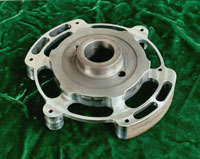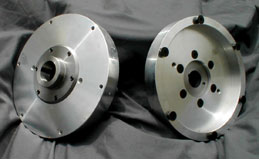Clutch upgrade
We had an ongoing problem with the original clutch. The typical symptom was that the clutch would not disengage fully, even though the cable was adjusted very tight. Disassembly revealed a broken clutch pushrod, but replacement only helped things partially; we still had problems with not having complete disengagement when the clutch heated up.

Full disassembly showed what I thought was poor condition of the clutch plates themselves. The pressure plate (which rides in the toothed ring) showed signs of having been hammered for some reason and was dished in the middle. I'm sure the situation was repairable (heck, these things ran for tens of thousands of miles 'back in the day') but it was universally suggested on the /2 list that I upgrade to the 'Earles fork' era clutch with a diaphragm spring.

The components I used were a /2 flywheel & pressure plate, 5mm clutch disk (the old one is shown in this picture, though), and a 'mid' clutch cover. One consideration on reassembly is the transmission clearance. The stack height of the newer clutch is no less than the old one, so one must still use the flush screws (but larger for the /2) in the clutch cover and not use spacers. My measurements indicated that the later button-head clutch bolts would interfere with the transmission cover by 1mm or 2mm.
One of the benefits touted was lighter weight, but the parts I received certainly were no lighter than the originals. The combined weight of the parts (less the friction disk) was 16 pounds for the original parts and 18.5 pounds for the later parts. The benefit comes from flywheel lightening, which is much easier on the later flywheel which doesn't have the spring holes.

photo courtesy BMW VMCA

photo courtesy BMW VMCA

To the left are lightened flywheels by Crescent Precision and Cycle Works. To the right is an aluminum flywheel by Barrington Motor Works.
For details on many of the clutch components from the plunger and Earles eras, look here.

